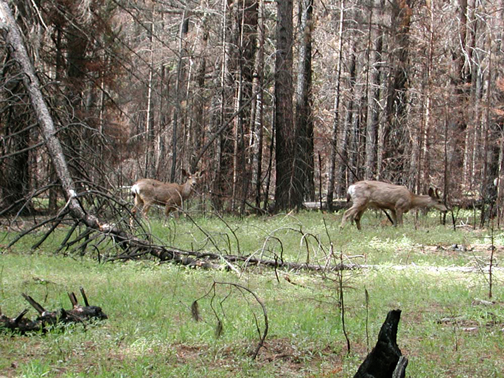U.S. Wildfire Cost-Plus-Loss Economics Project
Wildlife
The Pacific Crest Trail, May 14, 2004. Taken near the southern entrance to the Mount Jefferson Wilderness Area from Highway 20 Santiam Pass, Oregon. In addition to being unsightly and dangerous due to the threat of falling limbs, trees and reburning, much of this trail segment has been closed or difficult to traverse since the 2003 B&B Fire Complex Fire because of accumulating debris. (Photo by B. Zybach, Oregon Websites & Watersheds Project, Inc.).
Wildlife. In addition to mortality of forest, range, and aquatic wildlife populations, direct losses include damage and destruction to a wide variety of common or protected habitats and to such amenities as viewing areas and feeding stations. Indirect losses include damage and destruction to pre-fire habitat improvement projects, population enhancement costs, and investments in wildlife research. Post-fire costs include reduced population productivity, foregone game management income, habitat restoration expenses, and related business, job, and tax losses. The loss of listed endangered animals and their habitat is included here.
Case Studies.
San Bernardino National Forest, California (Loomis et al. 2002)
Smith, Jane K., L. Jack Lyon, Mark H. Huff, Robert G. Hooper, Edmund S. Telfer, and David S. Schreiner 2000. Wildland Fire in Ecosystems: Effects of Fire on Fauna. General Technical Report RMRS-GTR-42-Vol. 1, USDA Forest Service Rocky Mountain Research Station, Ogden, Utah: 83 pp.
Property
|
|||||
Energy
|
Heritage
|
© 2009 Oregon Websites & Watersheds Project, Inc. and Western Institute for the Study of the Environment.
